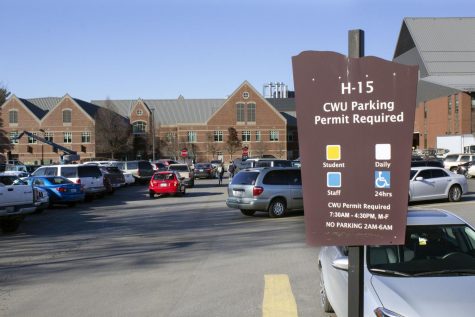Where do I Park?
February 19, 2020
“I don’t drive my car anywhere anymore,” freshman Kennedy Shook said, speaking in regard to how parking on campus affects her. “When I do move my spot, I have to go park out all the way in the street where it’s more likely that my car is going to get hit and damaged.”
According to data from the CWU website, there are currently 4,456 parking stalls on campus to accommodate a student population of 12,257. ASCWU and University Police & Public Safety have been working together to alleviate congestion for students parking on campus.

CWU Chief of Police Jason Berthon-Koch said part of the problem is a culture of people wanting to park directly next to their destinations, which don’t always have space available. Particularly, this problem is seen during the busiest hours of the day, from 10 a.m. to 2 p.m. due to class schedules.
“We’re going to have parking restraints, or parking complaints, because people can’t park right next to their building,” Berthon-Koch said. “But what I’ll tell you is that during that time frame, we have parking lots that are available with a 1% usage, but they’re farther away.”
Another reason for potential overcrowding is the amount of parking passes sold. Slightly over 5,000 permits are sold for the 4,456 stalls on campus, according to ASCWU Vice President for Student Life and Facilities Mickael Candelaria.
“The reason for that is because sometimes there are students that really are only on campus using that parking permit for a specific set of times,” Candelaria said.
Shook said the lack of convenient parking is something students are facing on a daily basis.
“Usually on the weekdays I have to park all the way out. Sometimes I park in the street, just because there isn’t enough parking,” Shook said.
Places Shook said were difficult to find parking, such as the SURC, the dorm buildings and outside of classes, are places on campus where students are spending longer periods of time.
“There’s so many kids who do have cars, and I don’t feel like there’s enough parking,” Shook said.
The growth of the student body is a challenge parking services is always facing.
“We understand that our population of students is growing,” Berthon-Koch said. “And we understand that there is a demand raising for parking, so we’re currently looking for solutions on that.”
One solution gaining traction is building a new multi-modal transportation hub. The new hub has been proposed but is still in the very early stages, Candelaria said.
Berthon-Koch said the vision for the hub includes bike racks with bikes that could be rented, a bus turnout for all the bus systems in the area and more available parking for both students and the community.
It would be built at the junction of University Way and Alder Street and would be shared between CWU and the county. The university would have ownership of the hub during the academic year and the county would have ownership over summers, according to Candelaria.
Funding for the project would have to be requested or come from parking services revenue. Parking services are funded and operate entirely self-sufficiently through parking fines and permit sales.
Berthon-Koch considers parking fines both a requirement to protect the resources of the students who pay for parking passes and a voluntary choice by people who park illegally.
“A lot of people don’t understand that parking only gets funded by permit sales, and not by any sort of state money,” Berthon-Koch said. “So when it comes to building parking lots, and building those types of things, parking has to look for alternate funding sources because it doesn’t generate the funds needed to do that activity.”
Shook supported the idea of a hub for transportation but had concerns about the current $236 price of parking permits impacting students.
“Not all of us have that money,” Shook said. “And … some of us don’t have financial aid so it comes out of pocket, so then it just makes it harder.”
The price of parking permits is increasing already. It increased 10% over the last year, approximately $20, and will increase another 10% this year. Over the next three years, it will increase another 5% each year, as part of a five year cycle.
“Once it goes through that [rate increase], parking on this campus … is still going to be cheaper than any other university back at the start of the five years.” Berthon-Koch said. “And they’re all going through increases.”

